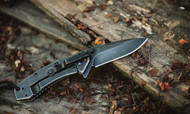Knife Terminology That Every Enthusiast Should Know
Sep 6 2023 - 9:26
Understanding the terminology associated with knives is a crucial part of being a knife owner. While this knowledge has many benefits, it mainly allows you to communicate with others effectively about different types of knives, their parts, and their uses.
However, there are many terms to remember, so we wanted to give everyone a refresher on some of the more popular terms. While some will be obvious to most knife users, others might not. So let’s dive into key terminology that every knife enthusiast should know to enhance their overall knowledge.
Blade
Let’s start with an easy one. The blade is the cutting part of the knife. It’s what most people think of when they hear the term “knife.” Blades can come in a variety of shapes and sizes, each with a specific purpose. The main types include the clip, drop, and tanto.
Edge
Despite the fact that the blade is a commonly known term, many people often mistake it for the edge. The blade is the whole piece of metal, while the edge is the sharp side of it. This is the part of the knife that does the actual cutting. The edge can be straight, serrated, or a combination of both.
Spine
The spine is the unsharpened side of the blade. It’s often thicker than the edge to add weight and strength to the knife. Not all knives have spines, though. Some of them have two edges instead.
Point
The final main part of a blade is the point. This is the very tip of the blade. It’s for piercing and detailed work. The shape of the point can greatly affect the knife’s performance. But all points are quite sharp.
Handle
After the blade, the next notable part of any knife is the handle. This is the part you hold while using a knife. There are a variety of materials that can form a handle, including wood, plastic, metal, or bone. Both mass-produced and professionally crafted handmade knife handles can use these materials. Regardless of the kind you get, any handle should offer a comfortable grip and good balance.
Tang
Now it’s time to cover some of the more unfamiliar knife terminology that most enthusiasts should know about. First off is the tang. This section of the blade extends into the handle for better stability. There are two types of tangs: full and partial. A full tang extends through the whole handle, offering maximum strength. A partial tang only partially extends into the handle.
Choil
The choil is the unsharpened part of the blade just before the handle. It provides a place to rest your finger near the edge when you need to apply precise control, typically for finer carving actions.
Jimping
Another safe place to put your fingers is on the jimping. The jimping refers to the notches cut into the spine of the knife to provide extra grip. This is also useful when precision is necessary. Plus, it helps keep your fingers away from the sharp edge.
Bolster
Finally, the bolster is the thick junction between the handle and the blade. It provides balance and helps protect the hand from sliding onto the blade. Not all knives have a bolster, but it’s a good safety feature to look out for.
